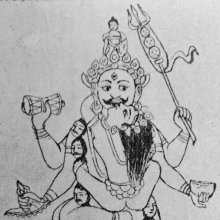Bhimadarshana, Bhīmadarśana, Bhima-darshana: 8 definitions
Introduction:
Bhimadarshana means something in Buddhism, Pali, Hinduism, Sanskrit. If you want to know the exact meaning, history, etymology or English translation of this term then check out the descriptions on this page. Add your comment or reference to a book if you want to contribute to this summary article.
The Sanskrit term Bhīmadarśana can be transliterated into English as Bhimadarsana or Bhimadarshana, using the IAST transliteration scheme (?).
Images (photo gallery)
In Buddhism
Tibetan Buddhism (Vajrayana or tantric Buddhism)
Source: archive.org: The Indian Buddhist IconographyBhīmadarśanā (भीमदर्शना) is one of the twenty-four Goddesses surrounding Buddhakapāla in the buddhakapālamaṇḍala, according to the 5th-century Sādhanamālā (a collection of sādhana texts that contain detailed instructions for rituals).—Buddhakapāla refers to one of the various emanations of Akṣobhya and the sādhana says that when Heruka is embraced by Citrasenā he gets the name of Buddhakapāla.—Bhīmadarśanā stands in the east of the outermost circle. She has a blue colour two arms, one face, ornaments of bones, brown hair rising upwards but no garlands of heads. She carries the kapāla in the left and the kartri in the right, and dances in the ardhaparyaṅka attitude.

Tibetan Buddhism includes schools such as Nyingma, Kadampa, Kagyu and Gelug. Their primary canon of literature is divided in two broad categories: The Kangyur, which consists of Buddha’s words, and the Tengyur, which includes commentaries from various sources. Esotericism and tantra techniques (vajrayāna) are collected indepently.
Languages of India and abroad
Sanskrit dictionary
Source: DDSA: The practical Sanskrit-English dictionaryBhīmadarśana (भीमदर्शन).—a. frightful in appearance, hideous.
Bhīmadarśana is a Sanskrit compound consisting of the terms bhīma and darśana (दर्शन). See also (synonyms): bhīmamukha.
Source: Cologne Digital Sanskrit Dictionaries: Edgerton Buddhist Hybrid Sanskrit DictionaryBhīmadarśanā (भीमदर्शना).—name of a. goddess: Sādhanamālā 502.10.
Source: Cologne Digital Sanskrit Dictionaries: Shabda-Sagara Sanskrit-English DictionaryBhīmadarśana (भीमदर्शन).—mfn.
(-naḥ-nā-naṃ) Frightful, hideous. E. bhīma, darśana appearance.
Source: Cologne Digital Sanskrit Dictionaries: Cappeller Sanskrit-English DictionaryBhīmadarśana (भीमदर्शन).—[adjective] of terrible aspect.
Source: Cologne Digital Sanskrit Dictionaries: Monier-Williams Sanskrit-English DictionaryBhīmadarśana (भीमदर्शन):—[=bhīma-darśana] [from bhīma > bhī] mfn. frightful in appearance, [Mahābhārata]
Source: Cologne Digital Sanskrit Dictionaries: Yates Sanskrit-English DictionaryBhīmadarśana (भीमदर्शन):—[bhīma-darśana] (naḥ-nā-naṃ) a. Frightful.
[Sanskrit to German]
Sanskrit, also spelled संस्कृतम् (saṃskṛtam), is an ancient language of India commonly seen as the grandmother of the Indo-European language family (even English!). Closely allied with Prakrit and Pali, Sanskrit is more exhaustive in both grammar and terms and has the most extensive collection of literature in the world, greatly surpassing its sister-languages Greek and Latin.
See also (Relevant definitions)
Partial matches: Darshana, Bhima.
Full-text: Bhimamukha, Buddhakapala.
Relevant text
Search found 2 books and stories containing Bhimadarshana, Bhīmadarśana, Bhima-darshana, Bhīma-darśana, Bhimadarsana, Bhima-darsana, Bhīmadarśanā; (plurals include: Bhimadarshanas, Bhīmadarśanas, darshanas, darśanas, Bhimadarsanas, darsanas, Bhīmadarśanās). You can also click to the full overview containing English textual excerpts. Below are direct links for the most relevant articles:
The Indian Buddhist Iconography (by Benoytosh Bhattachacharyya)
Maha Prajnaparamita Sastra (by Gelongma Karma Migme Chödrön)
Part 3 - The Prajñāpāramitāstotra < [Chapter XXIX - The Virtue of Wisdom]

